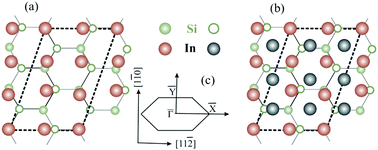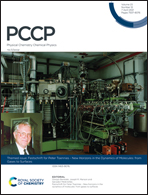Abstract
Electron–phonon interaction in the Si(111)-supported rectangular  phases of In is investigated within the density-functional theory and linear-response. For both single-layer and double-layer
phases of In is investigated within the density-functional theory and linear-response. For both single-layer and double-layer  structures, it is found that the phonon-induced scattering of electrons is almost exclusively determined by vibrations of In atoms. It is shown that the strength of electron–phonon coupling at the Fermi level λ(EF) increases almost twofold upon adding the second In layer. One of the reasons is that additional low-frequency modes appear in the phonon spectrum, which favors a strong enhancement of λ(EF). The agreement of the calculated parameter λ(EF) = 0.99 for a double-layer structure as well as the superconducting transition temperature Tc = 3.5 K with experimental estimates indicates that the discovered superconducting phase is probably a double-layer rectangular
structures, it is found that the phonon-induced scattering of electrons is almost exclusively determined by vibrations of In atoms. It is shown that the strength of electron–phonon coupling at the Fermi level λ(EF) increases almost twofold upon adding the second In layer. One of the reasons is that additional low-frequency modes appear in the phonon spectrum, which favors a strong enhancement of λ(EF). The agreement of the calculated parameter λ(EF) = 0.99 for a double-layer structure as well as the superconducting transition temperature Tc = 3.5 K with experimental estimates indicates that the discovered superconducting phase is probably a double-layer rectangular  -In structure on Si(111) with a coverage of 2.4 ML. This conclusion is also supported by good agreement between the calculated electron band structure and ARPES measurements.
-In structure on Si(111) with a coverage of 2.4 ML. This conclusion is also supported by good agreement between the calculated electron band structure and ARPES measurements.

- This article is part of the themed collection: Festschrift for Peter Toennies - New Horizons in the Dynamics of Molecules: from Gases to Surfaces



 Please wait while we load your content...
Please wait while we load your content...
 structures on Si(111) from first-principles
structures on Si(111) from first-principles